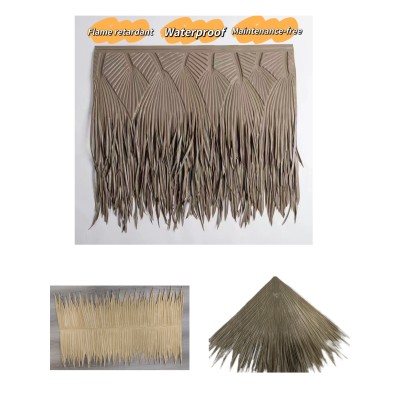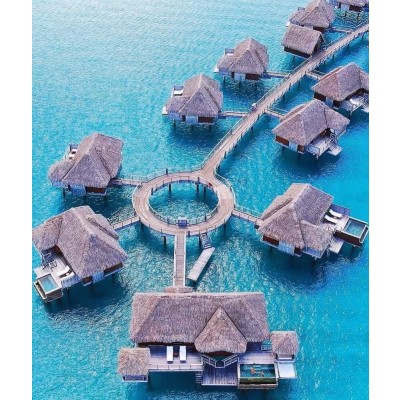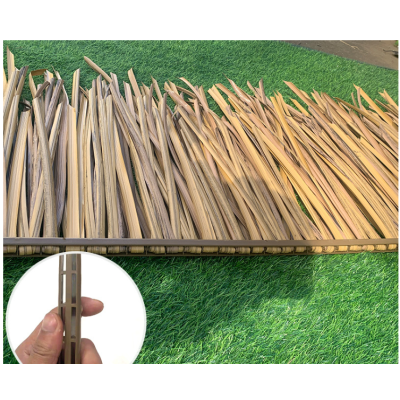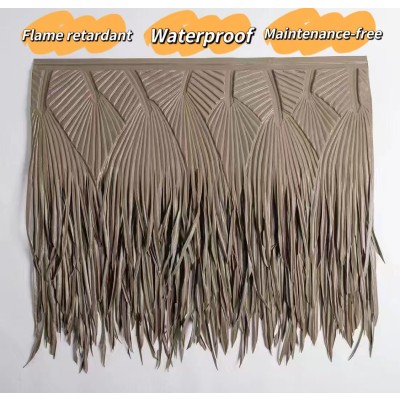Synthetic Tahiti Palm thatch: a roofing material that is both beautiful and practical
Synthetic Tahiti Palm thatch: a roofing material that is both beautiful and practical
Although the traditional Tahiti and Fiji palm thatch has unique natural aesthetics and cultural value, it also has some shortcomings in actual use. The following is a detailed introduction:
First, limited durability
1. Susceptible to natural factors: Palm thatch is exposed outdoors for a long time and is easily eroded by natural factors such as wind, rain, sunlight and humidity. In strong winds, thatch may be blown or damaged; Prolonged sun exposure will dry and brittle thatch, reducing its toughness and service life; High humidity can lead to mold and rot.
The service life is relatively short: even under normal use and maintenance, the service life of palm thatch is usually only a few years to a dozen years, and it needs to be replaced regularly, which increases the maintenance cost and workload of the building.
Second, poor fire performance
1. Flammable materials: Palm thatch belongs to flammable materials, once encountered fire source, it is easy to cause fire, and the fire spread fast, difficult to control. In dry climate conditions or areas close to fire sources, such as kitchens, campfire areas, the use of palm thatch has a greater safety risk.
Third, insufficient waterproof performance
Structural characteristics lead to the risk of leakage: it is difficult to completely seal the palm thatch roof or the wall laying way, there are certain gaps and pores, in the case of heavy rain or continuous rain, it is easy to leak phenomenon, resulting in indoor moisture, affecting the comfort of living and the preservation of items inside the building.
Fourth, high maintenance costs
Regular inspection and replacement: In order to ensure the safety and service life of palm thatch buildings, it is necessary to regularly inspect and maintain the thatch, and timely find and replace damaged thatch. This requires professional personnel and a certain time cost, and the material cost of replacing thatch is also relatively high.
Pest control and rodent control problems: Palm thatch is easy to attract insects and mice and other small animals nesting or gnawing, need to take additional pest control and rodent control measures, such as spraying insecticides, set up protective nets, etc., which also increase the complexity and cost of maintenance.
6. Resource access and processing restrictions
Resource sustainability issues: Although Tahiti and Fiji are rich in palm tree resources, with the increasing demand for palm thatch, if it is not properly developed and utilized, it may cause over-harvesting of local palm tree resources, affecting the ecological balance and sustainability of resources.
Processing is limited by seasons and manpower: the collection and processing of palm thatch usually need to be carried out in a specific season, and the processing process is more complicated, requiring certain professional skills and manpower, which limits its large-scale production and application to a certain extent.
Eight, synthetic Tahiti palm thatch came into being
Tahiti palm thatch with its unique tropical appearance, has long been favored, is widely used to create holiday wind, natural wind building roof. Nowadays, with the development of technology, synthetic Tahiti palm thatch came into being, which overcomes many drawbacks of natural thatch while retaining the original beauty.
1. Raw materials and preparation process
JHYBAMBOO synthetic Tahiti Palm thatch is usually made of high quality polymer, such as polyethylene, polypropylene, etc. These materials have excellent weather resistance, flexibility and strength. First, the raw material is mixed in precise proportions, adding specific additives, such as ultraviolet stabilizer, to enhance its resistance to direct sunlight damage; Then, through the advanced extrusion molding process, the material formed a slender and flexible shape similar to natural palm thatch; After the surface texture treatment, imitate the rough texture of natural thatch, so that the finished product is visually realistic.
Second, performance advantage
1. Durability:
Compared with the service life of natural thatch of 3-5 years, synthetic thatch can be as long as 10-20 years or more. It will not decay as quickly as natural thatch due to rain erosion and microbial decomposition, and can keep the roof intact and beautiful for a long time.
2. Fire resistance:
Natural thatch is flammable and a major fire safety hazard, while synthetic thatch is treated with flame retardant and reaches B1 level or even higher fire protection standards, effectively reducing fire risk and escorting building safety.
3. Installation convenience:
Synthetic thatch is light in weight, generally only 0.8-1.5 kg per square meter, much lower than the weight of wet natural thatch, reducing the load-bearing pressure of the roof. And its installation is more convenient buckle or gluing way, without professional complex weaving skills, greatly shortening the construction period.
4. Low maintenance cost:
No need to regularly flip and replace rotten parts like natural thatch, just occasionally clean up dust and debris, you can always be as new, saving a lot of manpower, material resources and time costs.
Third, aesthetic presentation
In appearance, synthetic Tahiti Palm thatch inherits the flowing, casual style of natural thatch. From a distance, the roof layers of "thatch" swaying in the wind, all look leisurely and comfortable; When viewed closely, the delicate texture and natural color, whether it is the warm tone of golden yellow or the cold tone of gray white, can perfectly integrate into all kinds of natural landscape or resort style architecture such as seashore and jungle, adding a strong romantic atmosphere to the space.
Fourth, environmental considerations
Although it is a synthetic material, its energy consumption in the production process is relatively low, and some products can be recycled. Compared with the damage that natural thatch collection may cause to the ecological environment, such as excessive deforestation affecting the palm forest ecology in Tahiti and other places, synthetic thatch satisfies people's yearning for thatch roof in a more sustainable way and helps to protect the ecological balance.
In short, with its excellent performance, attractive appearance and environmental characteristics, synthetic Tahiti palm thatch is gradually becoming a popular choice of building roofing materials, opening a new chapter in characteristic architectural decoration.



